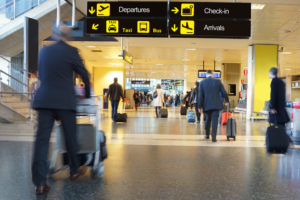
Facial recognition and artificial intelligence (AI) technologies can help us make the travel experience less alienating. This may seem like a very controversial statement, but let’s explore it further before we jump to any conclusions.
Many of us have experienced a marathon journey through an airport, dreading the endless queues and repeated security processes, leaving us feeling like an item on a manufacturing line. So, how could technologies help make our airport experience smoother?
Facial recognition technology has started to be deployed in airports worldwide in the last couple of years as a response to streamlining the passenger experience at airports. Today, some airlines are letting travelers board or self-drop their bags with just a facial scan. In particular, in the US there are many ongoing trials for biometric boarding such as the one launched in Los Angeles Airport last December, as part of the EXIT Program which launched in October 2017.
Biometric on-boarding will only continue to expand further. The objective of this innovative way to board a plane is to speed up the average boarding time as well as increase the level of customer service for passengers. So far, facial recognition is holding its promise as most passengers enjoy being verified in just seconds by walking past a camera. Furthermore, this technology allows airlines to board 285 passengers in less than 20 minutes. This is two times faster than the manual process, whereby the airline staff verifies each passenger’s passport and boarding pass.
What is AI and how does it benefit the travel experience?
Kaplan and Haenlein define AI as “a system’s ability to correctly interpret external data, to learn from such data, and to use those learnings to achieve specific goals and tasks through flexible adaptation”.
But what does this mean in the context of a journey through an airport?
I smile in anticipation when I imagine myself explaining what AI is to my two wonderful children, aged 8 and 10. I can picture their empty looks and nervous giggles while I attempt to explain such conceptual things in simple words. I like this exercise of trying to explain a concept that can be difficult to understand to your child or your grandmother as I find it always helps to put things in simple and basic terms.
If I had to transpose what AI is in simple terms and explain how it could make traveling easier to my two little smarties, here’s what I’d do. First, I’d describe the context: a typical airport journey.
Airports can be overwhelming for children as well as for any first-time traveler and can even make seasoned travelers anxious too. From the moment you book your ticket to the moment you finally settle on your assigned seat, it’s quite an expedition on its own. You need to make sure you have all the necessary documents, grab your things, rush to the airport, park right, get the terminal right, find the right hall, etc. Sometimes you can already use a coffee break after that, especially if you are travelling with children. But getting to the airport is just the beginning of the journey!
The next step is joining the queue at check-in to get your boarding pass and present your passport. If you’ve already checked-in from home, this is great as it might mean one step less for you, but you still need to queue to drop off your bags and present your passport and boarding pass to a member of staff.
Feeling lighter? Good, you’re now ready to stand in a line for the security check. This could take at least 15 minutes in the best-case scenario! And then you get to hear “Your boarding pass please!” all over again.
At this point, after undressing and dressing again, moaning about having picked the wrong pair of shoes and missed the hole in your right sock, dropped your phone twice and forgotten a bottle of shampoo in your hand luggage, you can usually use a shower.
But you feel valiant, it’s great that we have 5 minutes to get some duty-free perfumes! But again, you need to present your boarding pass when purchasing. Boarding pass, boarding pass, where did I put my boarding pass….
So, there you are, finally queuing to get in the plane after a race through the halls to your gate. The voice says: “Please have your boarding pass and your ID handy!”
Feel familiar?
The benefits of using our faces as a unique mark to prove who we are and let us access an area or a plane instead of pulling out passports and boarding passes all the time is quite easy to understand. Then comes the less obvious part.
AI and what it brings to face recognition technology
I’d again need to set the scene straight for my two little monsters here, explaining what AI actually does. AI is a machine or computer system that is programmed by us humans to be able to learn from the information it has stored and be able to use it to solve problems – just like our brains work. I’d probably ask them what intelligence is and get a flurry of contradictory answers. So, to settle the debate, I’d say there’s no single right answer, as there are many different types of intelligence.
We often take shortcuts when trying to define what intelligence is, and in most cases we end up with a definition that is too restrictive, culturally anchored and limited to a certain group of people at a given point in time, while circumstances and our understanding of the latter are continuously changing. So to remain simple, yet open, I’d offer to agree on defining intelligence as our capacity to connect information, such as things we’ve seen, read, heard, felt, smelled, sensed, etc. to new situations and being able to use our past experiences to deal with unknowns or anticipate possible outcomes. Transposing this to a computer system, AI could do all that but in a much faster way, and with exponential capacity. A bit like pulling together the experiences and intelligence of thousands of human brains!
As AI is able to capitalize on enormous amounts of collected data that can be used to solve problems, this allows facial recognition to continue getting better, enhancing our trust in such technology and the potential uses for it.
Now back to our first statement.
How can facial recognition & AI help make air travel more human?
We are already seeing the benefits in terms of efficiency brought by facial recognition technology, allowing passengers to be cleared to board using their face and a computer program enhanced with AI, instead of showing their documents to airline staff who will compare names and faces manually.
But the most interesting part is that we are learning from current deployments. The introduction of such technology is welcomed by both operators and travelers, who see the benefits in terms of security, time saving and ease of use, as well as the positive impact on the overall experience. So yes, technology is actually improving humanity, in the sense that it helps us focus on the human interaction and on things that cannot be automated such as a welcoming smile, assistance for special needs, answers to particular questions.
When technology reaches the point where it has the computing power and maturity to automate repetitive, time consuming processes that are mandatory to ensure security but also make passengers and operating staff feel alienated, it is ready to become mainstream. We have reached this point with AI-powered facial recognition and will start witnessing how it can really help improve the travel experience and bring back the notion of humanity that is often lost in heavy and time-consuming airport processes.
How can AI revolutionize the airport ecosystem?
Now, besides the use of AI to constantly improve the speed and accuracy of facial recognition algorithms, it also has the potential to revolutionize the entire airport ecosystem. There are already many systems deployed in airport and airline processes that collect passenger data through a diverse network of devices and applications, such as airline reservation systems, frequent flyer apps, passport readers, fingerprint scanners, cameras etc. In the future, AI could help stitch together the data collected by all those sensors and clearly establish that a passenger is who they claim they are.
From there you can ensure an identity is valid and you are eligible to pass a check point or use a service. This trusted identity is then the key to solve more inefficiencies of existing airport processes that are held by different parties and operated in isolation, which is precisely what is making the journey through an airport feel so inhuman. AI will be at the heart of the entire journey through the airport, allowing for a smooth yet secure walk through all the passenger touchpoints.
This full digitization of the traveler experience is the playground for the future attractiveness of air travel, where airports will race to become zero-queue environments that are able to ensure the best experience and anticipate hiccups from curb to gate.
At the Paris Air Show last week, we demonstrated how we’re making flight boarding easier, smoother and faster with facial recognition technology for airport security.
Get ready for a new era of airport travel where friendly agents and responsive flight attendants, who are there to focus on service rather than procedures, will greet you at paperless terminals!

